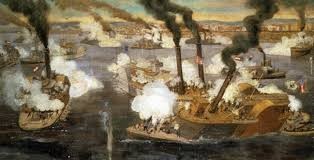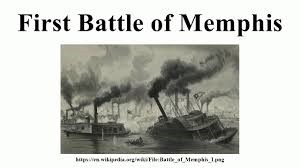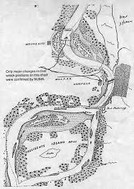Battle of Memphis Historical Marker
Introduction
Text-to-speech Audio
Images
An artist's depiction of the brutal close quarters fighting.

Listing ship in the Battle of Memphis

Map showing locations of sunken ships during the Battle of Memphis

Naval Battle of Memphis Historical Marker

Backstory and Context
Text-to-speech Audio
In the early hours of June 6th, 1862 five Union Ironclads and two Ram ships set out to meet the Confederate fleet on the Mississippi River just offshore from Memphis. The Union fleet, commanded by Flag-Officer Charles H. Davis and Col. Charles Ellet, consisted of the Ironclads Benton, Louisville, Carondelet, Cairo, and St. Louis complemented by the Ram ships Queen of the West and Monarch. The Confederate fleet, commanded by Captain James E. Montgomery and Brigadier General M. Jeff Thompson, consisted of eight Ram ships, the General Beauregard, General Bragg, General Price, General Van Dorn, General Thompson, Colonel Lovell, Sumter, and Little Rebel.
The Confederates had defeated the Union fleet at Fort Pillow on May 10th and were rather overconfident in their ability to defeat this new threat at Memphis. A major problem facing the Confederates, however, was that civilians captained their ships and these men lacked military experience. Also, the gun crews were Army personnel who only answered to their commanding officers. This led to disruptions in the chain of command which played a role in the inability of the Confederates to hold their ground. The Union chain of command fared little better in the ensuing chaos, but their superior force led to victory.
The opening salvos began at 5:30 am as the Confederate forces formed a battle line against the oncoming Union fleet. After a mere fifteen minutes of exchanged gunfire, Ellet pressed through the Union Ironclads and attacked the Confederate fleet. In just under two hours the Union forces had sunk three Confederate ships and captured four others while losing only one ship. The General Van Dorn was the only Confederate ship to escape the battle.
The Union victory at the Battle of Memphis, along with victories at New Orleans and Shiloh, eliminated Confederate Naval presence in the Mississippi River for the remainder of the war. The loss of the Mississippi disrupted Confederate supply chains and aided the Union. Without control of the Mississippi River, it became ever increasingly difficult for the Confederates to supply and resupply their forces.
Sources
1. ABPP. CWSAC- Battle of Memphis. Accessed 3/30/2017. https://www.nps.gov/abpp/battles/tn004.htm.
2. Rickard, J. Naval Battle of Memphis 6, June 1862. May 27th, 2007. Accessed 03/30/2017. http://www.historyofwar.org/articles/battles_memphis_naval.html.
